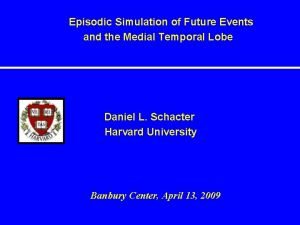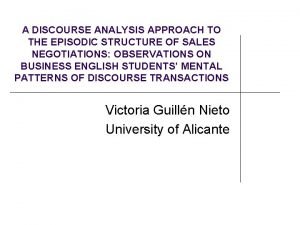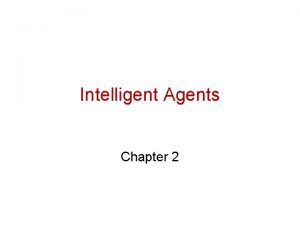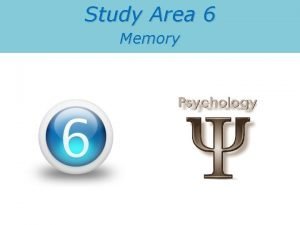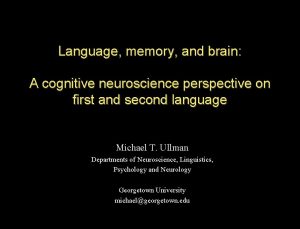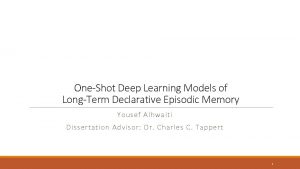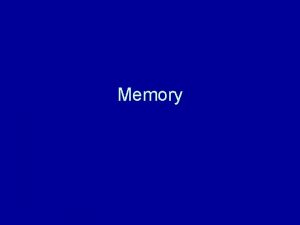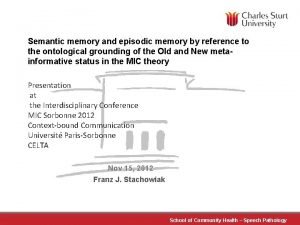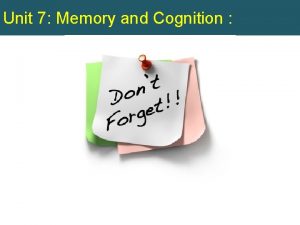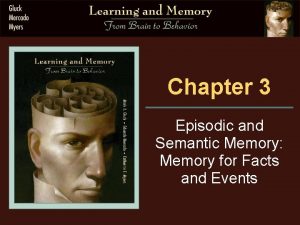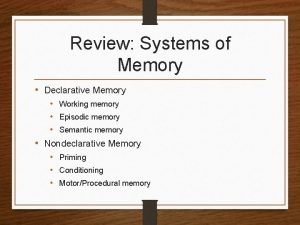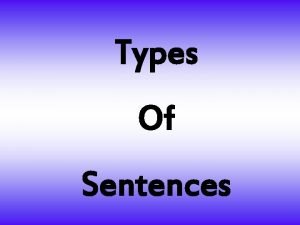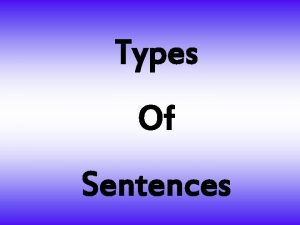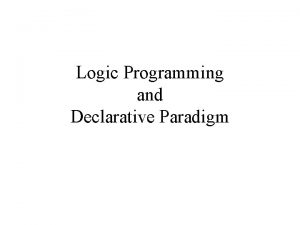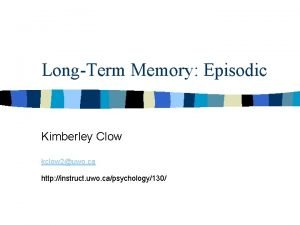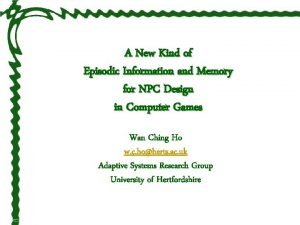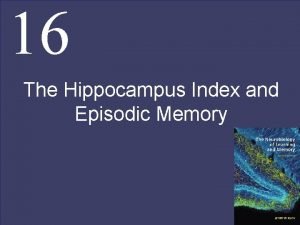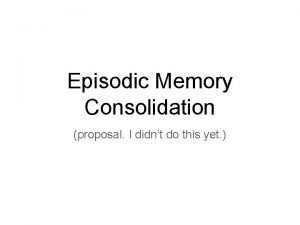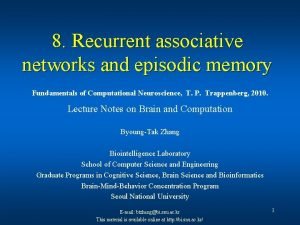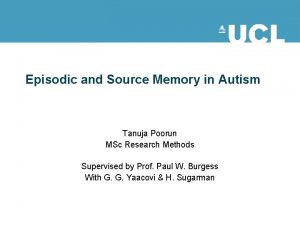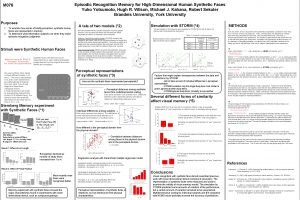Declarative Memory Declarative or episodic memory is for

































- Slides: 33

Declarative Memory Declarative or episodic memory is for arbitrary and non-repeated associations. For� example, when birds or squirrels store seeds for the winter they must remember the arbitrary locations and their contents (episode) even if they have just been to the particular places just once and several months earlier. In humans it would mean remembering a particular person and what they said (an episode) as opposed to learning a motor skill or improving one’s perception. There is extensive evidence that the hippocampus if essential for episodic memory in humans and animals. So the next section will cover: 1. Hippocampal anatomy. 2. Evidence that the hippocampus is essential for human memory. 3. What does the hippocampus do in other animals? 4. Spatial maps 5. Hippocampal and entorhinal cortex physiology- rhythms. 6. Hippocampal and entorhinal cortex physiology- place cells. 7. Non-spatial hippocampal memory. 8. Tentative conclusions. 9. Hippocampal cellular physiology. 10. Consolidation. 11. Adult neurogenesis in the hippocampus

The hippocampus: anatomy 1 The hippocampus is medial pallium- that is, it is arises from the dorsal medial part of the neural tube (bounded by the ventricle). This is seen in reptiles, birds and mammals like the opossum. In primates especially the growth of the brain drags the hippocampus into the temporal lobe. In all cases the hippocampus is a 3 layer cortex. It has two main subdivisions: the dentate gyrus (DG) and the cornu ammonis (CA). The CA is itself subdivided into 2 regions: CA 1 and CA 3. Connecting the 3 layer hippocampus to the standard 6 layer neocortex are 2 regions intimately involved in hippocampal function: the subiculum and entorhinal cortex.

The hippocampus: anatomy 2 Here is a classic image from Ramon y Cajal illustrating the principle cells (excitatory projection cells) of the hippocampus (we won’t deal with the numerous GABA interneurons). The DG has modified pyramidal cells (called granule cells) that have only apical dendrites. The CA fields contain fairly typical pyramidal cells with both basal and apical dendrites, both covered in spines.

The hippocampus: main input The hippocampus gets most of its input from neocortex. Not directly but via the entorhinal cortex. These entorhinal to hippocampal projections go to both the CA, CA 1, 3 fields and to DG. The entire cortex can influence the hippocampus this way. In addition the hippocampus receives input from septum and hypothalamus via the fornix/fimbria.

The hippocampus: schematic connections Plasticity: 1. Perforant pathway: postsynaptic LTP and LTD (NMDA-R dependent). . 2. Mossy fibers: presynaptic LTP (NOT NMDA-R). 3. Schaffer collaterals: postsynaptic LTP and LTP (NMDA-R dependent). This diagram illustrates the famous trisynaptic pathway. Fibers from the entorhinal cortex reach the DG via the perforant path and contact the DG granule cell dendritic spines. The DG granule cells then project mossy fibers to the proximal apical dendritic spines of CA 3 pyramidal cells. The CA 3 pyramidal cells then project (Schaffer collaterals) to the CA 3 apical dendritic spines. CA 3 pyramids the project out of the hippocampus. Also shown is the projection of CA 3 pyramidal cells down to the hypothalamus (mamillary body) via the fornix (this pathway is both input and output).

The hippocampus: detailed connections

Deficits after hippocampus damage in humans A classic measure of human declarative memory- remembering faces- is completely wiped out in patients with bilateral hippocampal damage. This and a great deal of related work initiated by the neurosurgeons, Drs. Penfield and Scoville and the neuropsychologist, Dr. Brenda Milner, clearly demonstrated the importance of the hippocampus for memory. Patients with frontal lobe damage are fine on this declarative memory task. In contrast frontal lobe, but not hippocampal damage produces deficits in the ability to change strategies in a card sorting task.

Memory remaining after hippocampus damage A motor task such as mirror drawing is normally learned by the famous hippocampal damaged patient, H. M. This is despite the fact that he was unable to remember doing this task from day to day. So sensory-motor learning is not affected by hippocampal damage. Neither is emotional learning.

Episodic memory in animals Here is the famous delayed non-match to sample task (DNMS); a variant of this task is delayed match to sample. The animal has to recognize, after a delay, an object different from the one it has seen previously. After an intertrial interval this task is repeated but with different objects. Humans, monkeys are very good at this task. Hippocampal damage completely wipes out this form of memory. Equivalent tests also work for rodents. This is a test for episodic memory and believed to be the animal version of declarative memory.

Spatial learning in animals (b) In the radial spatial maze all the arms are initially baited with food. Once the rat finds and eats the food in a maze arm, it is not replaced. The rat quickly learns to NOT visit the arms it has already visited (they no longer contain food). This is an example of an episodic memory that involves the rat remembering specific spatial locations. Hippocampal lesions completely wipe out this form of memory. Note: Olton originally called this working memory but that term is used in a different way now. (c) In this case some arms are never baited. Again the rat figures this out and never visits the unbaited arms. This type of learning is not permanently prevented by the same hippocampal lesions. So spatial learning is quite subtle.

Hippocampal activation during spatial navigation: Landmark Learning Subjects (human) navigated through a virtual town on a computer screen. Their brain activity was monitored with positron emission tomography (PET). The regions with the greatest increases in activity were the right hippocampus and the left caudate (part of the striatum). This clearly implicates the hippocampus in the processing of spatial information. The only spatial information available in this task is the spatial relations of objects in the environment. These are known as landmarks and it is thought that learning the relative position of landmarks is critical to spatial learning.

Spatial navigation: Path Integration in insects (b). Detours are imposed in the ant’s path. The animal takes into account the distance and direction it has traveled during the detour and still finds its way home. (a). An ant leaves its nest (N) and forages with a very complicated path until it finds some food (F). It then carries the food back to the nest via a direct path. The ant must somehow take into account all the twists and turns it has made as well as the linear distance it has traveled in any direction. In mathematical terms this is easy to do. For example, lets imagine that you know the velocity of an object and its final position. Velocity is the derivative of distance with respect to time; so if you integrate velocity you get back the distance traveled. This information + the final position allows you to compute the initial position. The same applies to rotations. Hence the term: path integration.

Spatial navigation: Path Integration in mammals These experiments were done with hamsters and in total darkness- no landmarks were visible. The arena is rotated at the beginning of each experiment. The animal is guided to food somewhere near the middle of the arena and must then find its way back. It succeeds in finding its way back presumably using only path integration. There have been many experiments demonstrating path integration in mammals. The neural basis of this ability is not known precisely. It presumably requires internal (idiothetic) cues as to the direction and distance of movements. This might come from several sources including: vestibular input, proprioceptive input and corollary discharge. At least vestibular input appears to be required for this ability and this information can reach the hippocampus. Head direction cells discharge when the animal’s head is oriented in a specific direction. So they do have the directional signal required. These cells are found in brain areas projecting to the hippocampus and so are likely involved in path integration. The consensus model is that landmark and path integration information are both required for spatial navigation and that these kinds of information are present in brain structures projecting to the hippocampus.

Spatial learning: the Morris water maze A rat is released into a tank full of opaque water. There is usually a landmark visible- a highly visible cue card at one position at the edge of the tank. The rat has to find its way to a platform that is under the opaque water and therefore invisible (or it will eventually drown). It quickly learns to do so. The rat is presumably using some combination of landmarks (the cue card) and path integration to solve this spatial problem. This is now the standard test for spatial learning in rodents. Lesioning the hippocampus prevents this spatial learning. A variety of interventions in the hippocampus also degrade this spatial learning. These include: blocking NMDA receptors (pharmacology or genetically), blocking Ca. MKII etc.

Spatial learning and the hippocampus Hippocampal lesions prevent rats learning the water maze. A strategy of numerous studies has been to use pharmacological or, more recently, molecular genetic means to perturb NMDA receptors (in the hippocampus) or their downstream targets and then measure synaptic plasticity (LTP), water maze learning and place cells (next section). The conclusion of most (not all) of these studies is that perturbing NMDA receptors blocks LTP and spatial learning and perturbs place cells.

Theta rhythms in hippocampus Neurons in the hippocampus (and elsewhere) often fire in a rhythmic manner at around 4 Hz. This is known as theta rhythm. Theta will occur during behaviors such as sniffing and during spatial navigation. The firing of place cells (next section) is often phase locked to theta rhythm. Synaptic plasticity (LTP) in hippocampus is maximized when the inputs are stimulated at theta rhythm: theta burst stimulation. The relationship between oscillatory discharge of hippocampal pyramidal cells, synaptic plasticity, spatial navigation and other learned discriminations is a subject under intense investigation and beyond the scope of this course. The cellular and network basis of theta and other rhythms is not understood and also the subject of intense study. There is other oscillatory activity in the hippocampus: gamma oscillations (30 -50 Hz) and high frequency “sharp-wave ripples”. The interactions and roles of these rhythmic activities is unknown.

Hippocampal Place Cells 1 A subset of hippocampal neurons discharge whenever the animal (typically a rodent) is in a specific location within the test chamber. Cell 1 in the figure discharges in the lower left region and continues to do so even after a partition is removed to create a larger chamber. Cell 2 does not discharge in the small arena but develops a place field after the barrier is removed. This figure begins to give you and idea of the complexity of place cells. It is known that, while place cell discharge can be controlled by visual landmarks, they can also occur in total darkness. This has led to the hypothesis that they are controlled by both landmark and path integration information; although there are theories about this relationship, they are not proven. Place fields are highly labile and many environmental manipulations will change place fields; the basis of this effect is not known. In most cases molecular genetic and other disruptions that interfere with LTP also reduce the stability of place fields and new spatial learning, but the causal relationships are not clear. There also many reports of hippocampal neurons that respond to non-spatial signals related to learning; for example, in association with eyeblink conditioning and odor discrimination.

Entorhinal Cortex Place Cells 1 Recent studies have shown that the entorhinal cortex contains very well defined place cells. These have a regular triangular pattern of place fields and the population of these cells can exactly code for the location of the animals. Further evidence demonstrates that place cells are first generated in entorhinal cortex and then passed on to hippocampus. How place cells are generated is not known exactly.

Entorhinal Cortex Place Cells 2 Entorhinal cortex place cell’s place fields are controlled by the location of a cue card. This implies that landmarks control the place cells. This makes sense since the rat must orient itself to structures in its environment. Entorhinal cortex place cell’s fields remain stable after long periods in the dark. This implies that path integration operates to maintain the place fields in the absence of landmark cues. So entorhinal place cells are generated by a combination of landmark and path integration inputs. Presumably these are linked together by plastic synapses but this is not understood. It is known that entorhinal place fields are rapidly generated and then remain stable but the cellular mechanisms are not known.

Non-spatial information in hippocampal place cells Here are examples of a place cells that discharge differently depending on the final destination. The cell in A discharged when the animal was going to turn to the left. The cells in B and C discharged when the animal was going to turn to the right. This is despite the fact that they traverse the same location no matter whether they will (later on) turn to the left or right. So hippocampal place cells can vary their discharge for complicated non-spatial reasons. There are numerous other examples of this type of behaviour.

Hippocampal Place and Episodic memory Place cell discharge rate is controlled by a non-spatial cue. Place cell spatial discharge pattern is controlled by differing locations with a constant non-spatial cue.

Hippocampus: memory for what and where: episodic and spatial? The figure to the left (a) represents theory that the hippocampus contains a map of space. The figure to the right (b) represents theory that the hippocampus codes for relationships: primarily between episodes (events- have I encountered the cylinder before and what does it mean to me? ) and where they occur (place fields- where do I expect the cylinder and near what else is it located? ). The evidence is more in favour of the “relational” hypothesis to the right although this subject is still at the center of intense research.

Hippocampal Cellular Physiology: LTP and LTD Different patterns of stimulation can induce LTP (theta burst) or LTD (low rates) in the same hippocampal pyramidal cell. The plasticity is specific to the pathway stimulated. The molecular basis involves NMDA receptors and the different affinities of Ca. MKII (kinase) and calcineurin (phosphatase) for Ca 2+. Very long lasting LTP (late LTP) also required transcriptional regulation and new protein synthesis. The theory (well supported) is that associating places with events requires LTP and LTD.

Consolidation 1 H. M. and other patients with hippocampal damage have anterograde amnesia; that is they are unable to retain long term memories for events (declarative or episodic memory) that occur after their hippocampal damage. In these and other cases the patients (or experimental animal) may be unable to remember events before the trauma (or experimental manipulation). This is retrograde amnesia. Typically retrograde amnesia is itself graded: it is most severe for events just before the trauma while events much further away in time may be remembered. This appears to be a paradoxical results: better memories for distant versus recent events. An quantitative example has been noted for electroconvulsive shock therapy (ECTfor depression); in this case memories for the 3 years prior to ECT were lost while earlier memories were intact. Hippocampal lesions in animals produce retrograde amnesias that range from a few days to 12 weeks.

Consolidation 2 These results (and many others) have led to theory that, after initial learning has taken place, there is a lengthy period during which the new memories become independent of the hippocampus- the initial site of storage. They now become more permanently stored in the neocortex. This process is referred to as consolidation. The term consolidation is also used to refer to the cascade of molecular interactions that convert LTP into very long lasting LTP (transcriptional regulation and new protein synthesis). I shall indicate the usage as appropriate. There is extensive evidence that cellular/molecular basis of behavioural consolidation includes transcriptional regulation, protein synthesis, the change (strengthening and weakening) of existing synaptic connections and the formation of new connections in hippocampus and cortex. There may also be an involvement of neurogenesis (next section). Hippocampus Temporary memory storage consolidation Molecular Cellular Network changes Neocortex Long term memory storage

Consolidation 3

Consolidation Theory According to one widely held theory episodic learning first involves rapid changes in hippocampal synaptic connections; the changes include both phosphorylation of synaptic proteins and new protein synthesis and last for hours to days. Subsequently the hippocampus transfers the new memories to neocortex over a period of days to weeks. The latter process might involve memory replay during sleep (in hippocampus) perhaps during sharp wave ripples.

Cellular Bases of Consolidation 1 Mice with heterozygous null mutation of Ca. MKII have impaired LTP in neocortex and do not consolidate memories. Memories are intact for a few days and then detiorate. Mice with homozygous null mutations do not have hippocampal LTP and do not form memories in the first place.

Cellular Bases of Consolidation 2 Radioactive 2 -deoxyglucose is used to probe for the distribution of high levels of activity during recall of recent versus remote memories.

Cellular Bases of Consolidation 3 An immediate early gene (c-fos) is used to probe for the storage sites of remote and recent memory traces in parietal cortex.

Adult Neurogenesis in Hippocampus Neural stem cells located in the subgranular zone (SGZ) of the hippocampus (on the ventricle) differentiate into immature neurons and then migrate into the dentate gyrus where they mature into DG granule cells. These cells then make appropriate synaptic connections.

Environmental conditions promote survival of newly generated hippocampal neurons Enriched environment for rats Greater number of neurons in DG of rats from enriched environments.

Development of new DG neurons Current evidence now suggests that new DG neurons may also be important in the storage of new memories- they appear to be more “plastic” than mature neurons. How this type of memory storage relates to consolidation and the transfer of memories from hippocampus to neocortex is not understood at all.
 Episodic vs semantic memory
Episodic vs semantic memory Constructive episodic simulation hypothesis
Constructive episodic simulation hypothesis In a climactic drama the plot begins early in the story
In a climactic drama the plot begins early in the story Episodic structure
Episodic structure Peas description for part-picking robot
Peas description for part-picking robot Teori agenda setting
Teori agenda setting The declarative memory that contains personal information
The declarative memory that contains personal information Declarative memory
Declarative memory Borra hål för knoppar
Borra hål för knoppar Redogör för vad psykologi är
Redogör för vad psykologi är Gumman cirkel
Gumman cirkel Bris för vuxna
Bris för vuxna Mat för idrottare
Mat för idrottare Ledarskapsteorier
Ledarskapsteorier Svenskt ramverk för digital samverkan
Svenskt ramverk för digital samverkan Datorkunskap för nybörjare
Datorkunskap för nybörjare Plagg i gamla rom
Plagg i gamla rom Fspos
Fspos Steg för steg rita
Steg för steg rita Ministerstyre för och nackdelar
Ministerstyre för och nackdelar Claes martinsson
Claes martinsson Tillitsbaserad ledning
Tillitsbaserad ledning Vem räknas som jude
Vem räknas som jude Dikter för barn i skolan
Dikter för barn i skolan Nyckelkompetenser för livslångt lärande
Nyckelkompetenser för livslångt lärande Personlig tidbok för yrkesförare
Personlig tidbok för yrkesförare Handledning reflektionsmodellen
Handledning reflektionsmodellen Varför kallas perioden 1918-1939 för mellankrigstiden?
Varför kallas perioden 1918-1939 för mellankrigstiden? Vilken grundregel finns det för tronföljden i sverige?
Vilken grundregel finns det för tronföljden i sverige? Stål för stötfångarsystem
Stål för stötfångarsystem Shivaiter
Shivaiter Big brother rösta
Big brother rösta Verktyg för automatisering av utbetalningar
Verktyg för automatisering av utbetalningar Expektans
Expektans

